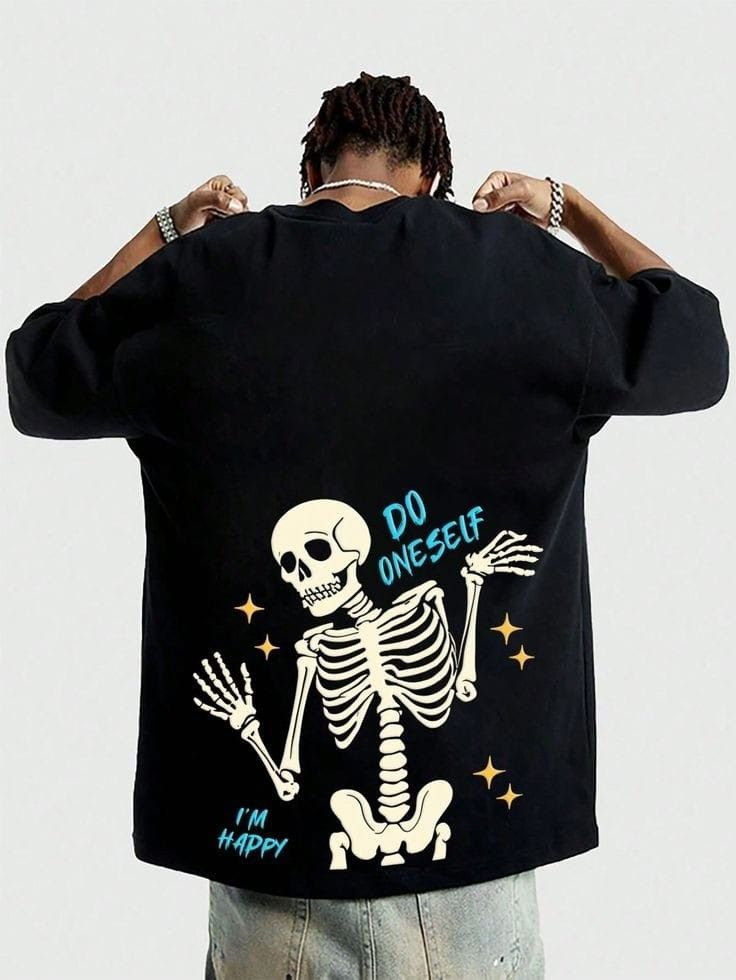Currently Empty: $0.00

Introduction: The T-shirt – A Global Fashion Staple
The T-shirt is one of the most universally recognized clothing items across the world. Simple in design, yet rich in cultural significance, it has evolved from a utilitarian garment into a symbol of self-expression, fashion, and identity. Worn by people from all walks of life, the T-shirt is not just an essential piece in any wardrobe but also a canvas for creativity, culture, and individualism. Over time, the T-shirt has become a powerful symbol of political movements, cultural revolutions, and artistic expression.
In this article, we will explore the rich history, various types, design techniques, materials, and the cultural significance of the T-shirt. From its origins as military wear to its modern-day role in the fashion industry, the T-shirt has undergone significant transformations that reflect broader societal changes. Whether it’s the graphic tees of the ’80s, the minimalist designs of today, or the rise of eco-friendly brands, the T-shirt remains a timeless and essential garment.
The Evolution of the T-shirt: From Military Gear to Fashion Icon
The story of the T-shirt begins in the early 20th century, during a period when workwear and military uniforms dictated the styles of everyday clothing. The T-shirt, originally known as an “undershirt,” emerged as a solution to provide comfort and practicality for soldiers during World War I. Made from soft, breathable cotton, it quickly became a preferred garment for military personnel. By the time the 1920s arrived, the T-shirt had become popular among civilians, particularly laborers and workers, for its comfort and ease of wear.
During World War II, the T-shirt’s popularity soared as it was used as a practical base layer for military uniforms. The simple, no-frills design allowed soldiers to wear it under their heavy uniforms, providing much-needed comfort. In the 1950s, the T-shirt broke into mainstream culture when Hollywood actors like Marlon Brando in A Streetcar Named Desire and James Dean in Rebel Without a Cause wore the T-shirt as an emblem of rebellion and youthful nonconformity. This moment in film history marked the T-shirt’s transition from an undergarment to a statement piece.
The 1960s and 1970s saw the T-shirt undergo further transformations. With the rise of pop culture and youth-driven movements, the T-shirt became a canvas for personal expression. Artists, political movements, and musicians embraced the T-shirt as a medium to communicate their beliefs, creativity, and affiliations. This was the era of graphic T-shirts, which featured slogans, logos, band names, and political messages. The 1980s brought about the popularity of band tees, with fans wearing shirts emblazoned with their favorite music acts, making the T-shirt a symbol of fandom and subculture.
Today, the T-shirt is a fundamental part of global fashion, worn by millions for casual, everyday use. It has been incorporated into high fashion as well, with luxury designers offering premium versions made from advanced materials and featuring intricate designs. The T-shirt’s role in fashion continues to evolve, with an emphasis on sustainability and customization, ensuring its place as a dynamic and versatile garment.
Types of T-shirts: From Basic to Bespoke
While the classic plain T-shirt remains a staple, today’s fashion scene offers a vast array of styles to suit every taste and occasion. Here are the different types of T-shirts available on the market:
- Basic T-shirts
The basic T-shirt is the epitome of simplicity and versatility. Typically made from soft cotton, these T-shirts are available in a wide range of colors and cuts. They feature no embellishments, making them ideal for layering under jackets, sweaters, or shirts. Basic T-shirts come in various fits, such as regular, slim, and oversized, allowing people to choose the silhouette that best suits their style.
- Graphic T-shirts
Graphic T-shirts are designed with bold prints, images, logos, or slogans that make a statement. These T-shirts often serve as canvases for self-expression, political commentary, or artistic expression. Popular among younger generations, graphic tees are frequently used to showcase band affiliations, pop culture references, or social justice causes. In the digital age, the customization of graphic T-shirts has become easier, allowing individuals to create their own designs or purchase unique pieces from independent artists.
- Performance T-shirts
Performance T-shirts are specifically designed for sports and activewear. Made from lightweight, moisture-wicking fabrics like polyester and spandex, these T-shirts are engineered to keep the wearer cool and dry during physical activity. Performance T-shirts are popular in sports, fitness, and outdoor activities, as the materials used help regulate body temperature and wick moisture away from the skin. Some performance T-shirts are also treated with antimicrobial finishes to reduce odor and bacteria.
- Designer and Luxury T-shirts
Designer T-shirts are a step up from the basic cotton tee, often crafted from high-quality fabrics and featuring unique, artistic designs. These T-shirts are produced by high-end fashion brands and luxury designers and are often priced higher due to their exclusivity and craftsmanship. Designer T-shirts may include intricate embroidery, premium fabric blends, or limited-edition designs that appeal to fashion-conscious consumers who want to make a statement through their clothing.
- Sustainable and Eco-friendly T-shirts
As the fashion industry becomes increasingly aware of its environmental impact, many brands have introduced eco-friendly T-shirts. These shirts are made from sustainable materials such as organic cotton, hemp, bamboo, and recycled polyester. Sustainable T-shirts are produced using methods that minimize environmental harm, such as reducing water usage, avoiding harmful pesticides, and utilizing eco-friendly dyes. With the rise of eco-conscious consumers, the demand for sustainable T-shirts has grown significantly in recent years.
- Vintage and Retro T-shirts
Vintage and retro T-shirts are a throwback to past decades, often featuring old-school designs, logos, and branding from bygone eras. These T-shirts have become highly collectible, with some vintage tees fetching high prices in the resale market. From classic concert tees to retro advertising shirts, these garments allow people to relive past trends and showcase their love for nostalgic pop culture.
Materials Used in T-shirt Manufacturing
The material of a T-shirt greatly affects its comfort, durability, and appearance. Different fabrics have different qualities that make them ideal for specific uses. Here are the most common materials used in T-shirt manufacturing:
- Cotton
Cotton is the most common material used for T-shirts. It is soft, breathable, and comfortable, making it perfect for casual wear. Cotton T-shirts are highly versatile and can be worn in various weather conditions. However, cotton production can be resource-intensive, requiring large amounts of water and pesticides, leading to concerns about environmental sustainability.
- Polyester and Blends
Polyester is a synthetic fabric that is durable, moisture-wicking, and quick-drying. It is commonly used in athletic T-shirts due to its ability to keep the wearer cool and dry during physical activities. Polyester is often blended with cotton to create a fabric that combines the comfort of cotton with the performance of polyester. Cotton-polyester blends are common in performance wear and casual T-shirts alike.
- Organic and Sustainable Fabrics
Organic cotton, bamboo, and hemp are some of the sustainable materials used in T-shirt production. Organic cotton is grown without the use of synthetic pesticides or fertilizers, making it a more eco-friendly alternative to conventional cotton. Bamboo and hemp are renewable resources that require fewer chemicals and less water to grow, making them popular choices for sustainable clothing.
- Innovative Fabrics
In addition to traditional fabrics, newer materials have been developed for performance and environmental purposes. For example, recycled polyester is made from post-consumer plastic bottles, helping reduce waste and promote sustainability. There are also high-tech fabrics designed to offer enhanced breathability, stretch, and moisture-wicking properties. Innovations in textile technology continue to shape the future of T-shirt manufacturing.
T-shirt Design and Printing Techniques
Designing and printing T-shirts has become an art in itself. Over the years, numerous techniques have been developed to create eye-catching and unique designs. Here are some of the most common methods used in T-shirt printing:
- Screen Printing
Screen printing is one of the oldest and most popular techniques for printing designs onto T-shirts. This method involves creating a stencil (or screen) of the design, which is then used to apply ink onto the fabric. Screen printing is ideal for bulk orders and simple designs but can also be used for intricate artwork. This method is widely used for mass production and promotional T-shirts.
- Direct-to-Garment (DTG) Printing
Direct-to-garment printing is a modern printing technique that uses inkjet technology to print high-resolution images directly onto the fabric. DTG printing allows for more complex and detailed designs, including full-color images and photographs. Unlike screen printing, DTG does not require a stencil or screen, making it ideal for smaller runs or custom orders.
- Heat Transfer Vinyl (HTV)
Heat transfer vinyl printing involves cutting a design out of vinyl material and applying it to the T-shirt using heat and pressure. The vinyl adheres to the fabric, creating a durable, high-quality print. HTV is popular for custom T-shirts, jerseys, and sportswear. It can be used for both simple designs and more intricate patterns, making it a versatile choice for personalization.
- Embroidery and Patches
Embroidery involves stitching a design directly into the fabric using thread. This technique adds texture and depth to the design, making it ideal for logos and more formal designs. Patches, which are typically embroidered, are applied to the shirt using heat or stitching. Embroidery and patches are often used in branded T-shirts, uniform shirts, or high-end fashion garments.
- Fabric Dyeing and Tie-Dye
Tie-dye is a classic technique that involves twisting or folding the fabric before applying dye. The result is a unique, colorful pattern that is often associated with bohemian and hippie cultures. Fabric dyeing, in general, can be used to create a wide range of effects, from subtle ombré patterns to bold, vibrant hues. This technique remains a popular choice for custom and handmade T-shirts.
The Role of T-shirts in Pop Culture and Society
The T-shirt’s influence extends far beyond fashion. It has played an integral role in pop culture, music, political movements, and social activism. T-shirts featuring band logos, iconic quotes, and political slogans have become powerful tools for self-expression. From the revolutionary slogans of the 1960s to the “I ♥ NY” shirts of the 1970s, T-shirts have served as vehicles for social change, branding, and personal identity.
In addition to their cultural impact, T-shirts have also become symbols of unity and solidarity. From protests to charity events, T-shirts are often used as a form of collective expression. Whether it’s a slogan supporting a political candidate, a message advocating for social justice, or a charitable cause, T-shirts are a way for people to come together and communicate their values and beliefs.
Conclusion: The Enduring Legacy of the T-shirt
The T-shirt is more than just a piece of clothing. It is a blank canvas that allows individuals to communicate their personalities, affiliations, and beliefs. From humble beginnings as a military undergarment to its current status as a global fashion staple, the T-shirt has continually adapted to the times while maintaining its core function as a simple, comfortable garment.
As we move forward into the future of fashion, the T-shirt will continue to play an important role in shaping trends, cultural movements, and personal expression. With innovations in materials, printing techniques, and sustainable production practices, the T-shirt will undoubtedly remain a timeless and essential item in wardrobes around the world for generations to come.

